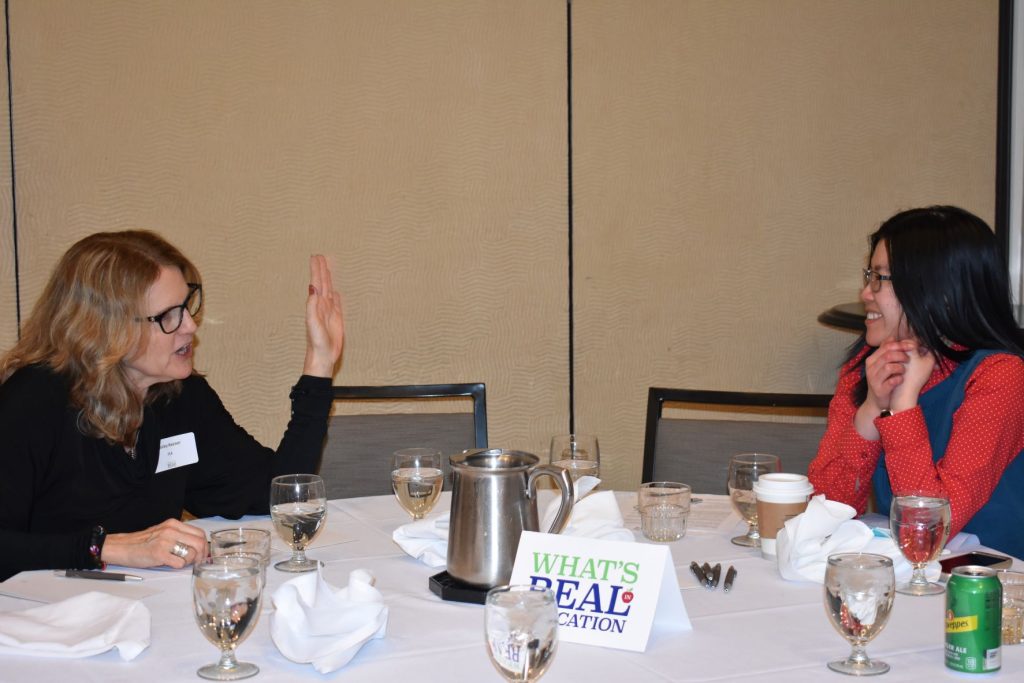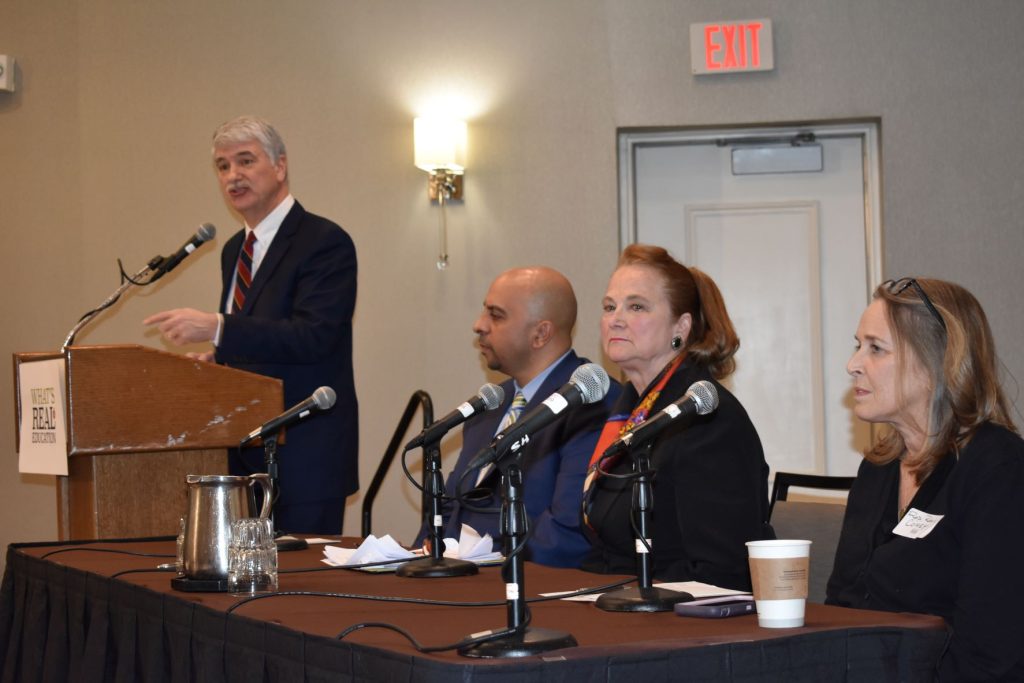The last several months have seen classrooms and board of education meetings turn into battlegrounds for everything from COVID protocol to curriculum.
What are educators to do when they’re faced with angry accusations, confused parents, and misinformation about what they teach? How can they ensure schools are strongholds of diversity, equity, and inclusion and dispel myths about what that means?
Those were the questions taken up at a Monday evening forum in Rocky Hill that brought educators, administrators, and lawmakers together for a discussion of What’s Real in Education.
The program—held in person and livestreamed—was a collaborative effort of CEA, AFT Connecticut, and the Connecticut Association of Public School Superintendents (CAPSS).
[Above, Daniel HoSang, Yale professor of Ethnicity, Race, & Migration and American Studies, moderates a panel of educators (L-R): Benie N’sumbu, Giselle Garcia, Leslie Blatteau, and Ruth-Terry Walden.]
Chilling effect
CEA President Kate Dias described significant abuse aimed at teachers and curricula in the context of public school board meetings, private emails, and social media—including recent threats that have had a chilling effect on Guilford educators by a group purporting to be watching everything they do.
Thirty-six states have passed or considered legislation to restrict educators’ ability to teach a broad range of subjects, including gender, sexuality, race, and racism. The list of banned books and materials grows longer each day, and more than a third of educators surveyed nationwide say they are more likely to leave the profession at the end of this school year in the face of laws that prevent honest teaching and conversations.
CEA President Kate Dias, together with CAPSS President Fran Rabinowitz and AFT Connecticut President Jan Hochadel, leads off the forum.
“This distortion and perversion of the work we do every day has brought us together to say we can’t let the noise be the only information that’s out there,” said Dias. “We have to bring our perspective to the table, let everybody know what’s real in education, and provide protection for our educators.”
“Teaching is a hard job,” AFT Connecticut President Jan Hochadel remarked, adding that student trauma and dysregulation forged by the pandemic have only made it harder. “We need to offer support systems for our teachers. We’re not getting the respect we deserve.”
That protection and support would come, in part, from a proposed Educator’s Bill of Rights that calls for freedom from intimidation, respect for the dignity and expertise of educators, equitable resources that are not limited by a school’s ZIP code, school communities that cultivate social emotional health for optimal teaching and learning, and recruitment and retention of diverse educators.
Educators speak out
The forum led off with a panel of classroom educators sharing their own experiences with anti-racist, anti-discriminatory teaching, including obstacles they have faced. They urged colleagues, administrators, and lawmakers to stand together to ensure Connecticut teachers are not sanctioned or silenced for teaching equity, diversity, and truth.
CAPSS President Fran Rabinowitz agreed. “Teachers are the most important asset we have in our schools, and our job is to ensure you have the environment where you can grow every child who’s in your care. We’re much more powerful when we’re one.”
Panelist Ruth-Terry Walden, an English teacher at Westhill High School in Stamford, recalled her start in teaching as a second career.
“Six weeks into teaching, I looked at the books on my classroom shelf and said, ‘I can’t use these books.’ They were all written by white men about other white men.” As a woman of color, Walden noted, “We’ve always been there; we just haven’t been in the history books. Women couldn’t see themselves in these books, and certainly Black children, brown children, and indigenous children couldn’t see themselves. Students have to be able to see themselves in their classroom to be engaged.” She added, “We need administrators and legislators to have our backs when we do this work.”

Educators share their experiences related to teaching equity and diversity.
Walden also noted that much of the curriculum that deals with Black, brown, and indigenous people is limited to their suffering and struggles without also acknowledging their successes. “We must convey the joy in their stories, the fact that our ancestors passed the torch and we endured.”
Fellow panelist and Manchester High School math teacher Giselle Garcia described her own experiences with teaching about race.
“Our school is engaging in a lot of work centered on race and equity,” Garcia said. “As a Puerto Rican woman, I think of my role and how I interact with students. We’re fortunate that we have anti-racist teachers creating anti-racist classrooms and that we’re all engaging in that training.”
She acknowledged, however, that teachers are “still working in a system that perpetuates the racism we’re trying to undo,” adding, “Teachers deserve to be viewed as professionals and trained experts in our field. We also have the right to be free from intimidation. Just the fact that teachers are being made to feel afraid to go into their classrooms and teach the truth has to change. Teachers shouldn’t have to sacrifice their professional lives.”
Panelist Leslie Blatteau, a world history teacher at New Haven’s Metro Business Academy and president of the New Haven Federation of Teachers Local 933, described anti-racist teaching strategies that she and her colleagues use, including checking with students to find out what they want to learn.
“That doesn’t mean throwing out curriculum,” she clarified. “It means empowering students with choice. American history is a history of Black resistance. We are teaching students that another world is possible. We have a right to teach our students the truth.”
One of the driving forces behind the campaign for Connecticut’s new Black/Latinx Studies high school course that won recent approval, panelist Benie N’sumbu is a former organizer with Students for Educational Justice, in New Haven. Like students, she said, teachers have been instrumental in agitating for change.
“I’m excited that there are teachers who are passionate, creative in their classrooms, and committed to teaching the truth,” N’sumbu said. “As long as we have teachers like these, and we support them, our children are in great hands.”
Shared goals
Legislators joined the discussion in a bipartisan panel of their own, emphasizing that education is an area where all lawmakers can and should come together.
Republican State Representative Kathleen McCarty, a former teacher herself, expressed pride in being a ranking member of the legislature’s Education Committee.
“If we keep our children centered first, we can’t go wrong in the legislation we pass,” she said. “Providing a quality education for all our students in Connecticut is our number-one priority.”
McCarty underscored what teachers have been reporting—namely, that the pandemic has exacerbated many of the issues educators see in their classrooms and that students desperately need more mental health and behavioral services.

CEA Executive Director Donald Williams asks legislators Cabrera, McCarty, and Comey for their perspectives on passing legislation critical to public education.
“We’re having ambulances take students to emergency rooms, and they’re returning to school without having received the services they need,” she said. Describing a common public perception that social emotional learning is “fluff” that somehow sacrifices precious instructional time, she said, “SEL is so important today. We’re teaching compassion, kindness, and critical thinking. What better way to engage our students than to make them aware of each other?”
Emphasizing that teachers’ role expands beyond academics, Representative Robin Comey, said, “We all remember our favorite teachers, because they inspired us in some way, but often the public—including some parents—don’t see it that way. Those are the misconceptions—that teachers connecting with students and taking care of social emotional needs is not important, or that it’s too ‘touchy-feely.’”
Characterizing mental health as one of the biggest challenges in public education, Senator Jorge Cabrera called for more school-based health clinics, school social workers, psychologists, and counselors, and a better continuum of care.
“Longer term,” he said, “the biggest challenge facing public education is keeping people in the profession. They are quitting.” Among his many suggestions for stopping the outflow of qualified teachers from the profession they love were making sure educators have “time to collaborate and space to decompress.”
Comey noted, “The inequitable allocation of limited resources in our state is also a challenge.”
“If we continue to rely on property taxes to fund our schools, we will continue to face the same challenges and inequities we’ve always had,” Cabrera agreed. “We’ve got to tackle that, because if we don’t, we’ll be having these same conversations over and over. Federal dollars are going to run out.”
Continuing the conversation
CEA Executive Director and former legislator Donald Williams, who moderated the legislative panel, praised Connecticut’s bipartisan tradition on education issues, saying “It’s worked in the past, and we need for it to work now and in the future.”
To that end, he asked how teachers can support legislators in pulling together colleagues from both parties on the issues of greatest concern to educators this year: school indoor air quality and mental health supports.
“Constant communication,” said McCarty, emphasizing, “It has to be ongoing. Don’t approach legislators with the idea that they have all the answers. Write good testimony. Make it real for us. Tell us what’s going on in the classrooms. Your voices matter. We do have to fight for the dollars to do what we say we need to do.”
She noted that a key piece of legislation she believes is likely to pass this session—a bill on indoor air quality—”came from CEA and this coalition. You brought these stories to us.”
“Keep gathering teachers and legislators together, like this,” said Cabrera. “Share your everyday work. I’ve received postcards from teachers in my districts, handwritten notes. It’s easy in the legislature to become removed from the work on the ground.”
CEA’s Kate Dias challenged teachers at the forum to keep the conversation going with legislators, letting all of their elective officials know what’s real in education.
“Where are you willing to give voice? How are you going to show people that prep time is typically spent counseling students and supporting families? It’s not preparing for lessons. That’s what teachers do at 5 a.m., when they’re photocopying, when they’ve had to fight to get there early. Talk to your colleagues too. Remind them, ‘You’ve got a really good story; you should share it.’ Tell parents, ‘You’ve got something important to tell your legislators; you should tell it.”
[ad_2]
Originally Appeared Here